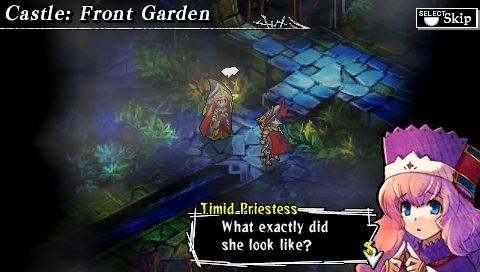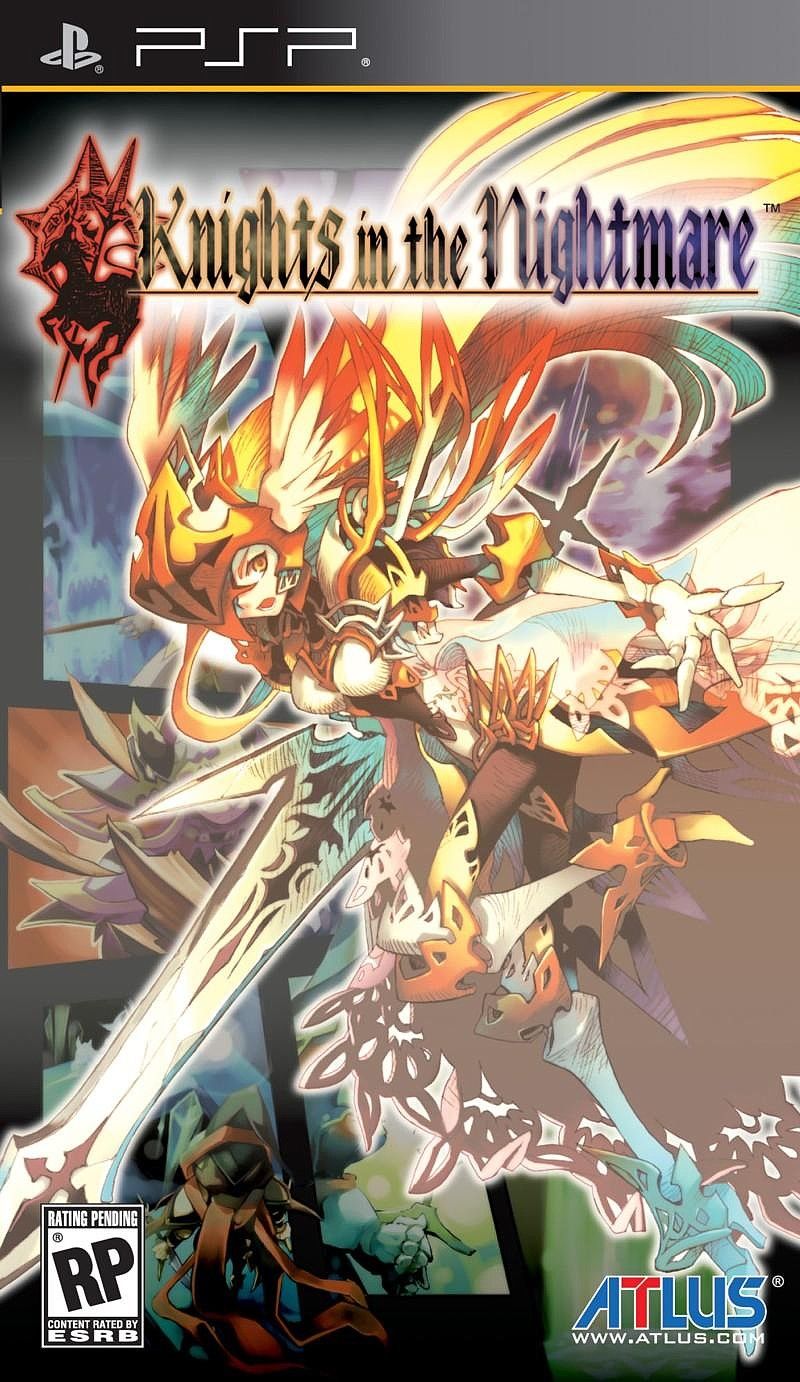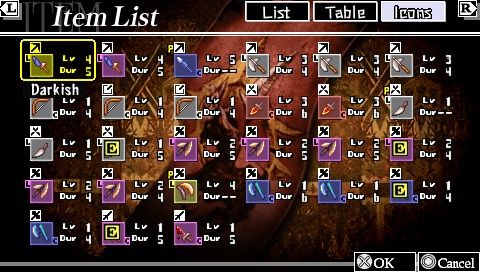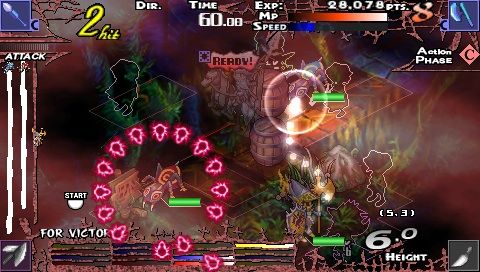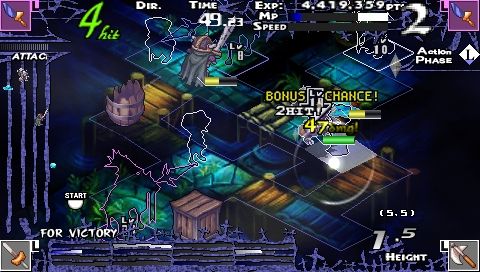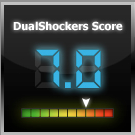I have to admit something: Knights in the Nightmare is one of the strangest, most convoluted games I’ve ever played. That isn’t necessarily a bad thing, but isn’t entirely good, either. I’m a fan of strategy RPGs when they really click with me, but unfortunately these games are few and far between. This particular title, however, ultimately did not work for me as much as I would have hoped.
Knights in the Nightmare was originally a DS title, and I did not play it back then. Although, the port over to the PSP seems to have spruced things up a bit, which is expected. We have improved visuals, the wide-screen format and new content, all rolled into the same crazy package – this time around on Sony’s little handheld that could. I definitely think this is the definitive version of this game, because I shudder every time I think about trying to play it on the DS (although, I’m sure the stylus might be a better control mechanism in this particular instance).
The game allows you to relive the tale of a long-destroyed kingdom through the eyes of deceased inhabitants. While things are very vague up front, as you progress and get to know the people who lived in this kingdom and helped to defend it, you’re able to piece together the story, and it is actually quite unique. I kept wanting to progress because each step you took forward means you found out something new and interesting about this kingdom, what led to its destruction, or a ton of other mysteries that crop up throughout the game.
The story isn’t the problem – in fact, the story is quite good. The issue here is that getting to those story chunks is awfully convoluted. Why? I’ll get to that in a moment. First though, the visuals really bring to life the whole solemn mood of the game as a complete unit. Like few other titles in the past, the visuals work well with the audio to create this sense of dread and demise, as you unravel the intricacies of what took place here. The voice acting, while passable, isn’t all that great, but it doesn’t ruin the overall experience.
As I mentioned, the issue here is with the learning curve of the battles system. And, even when you think you know what’s going on, you really don’t and you will get WTF-stomped by a battle you think you can cruise right through. It definitely takes some time to get familiar with the controls and the whole battle setup. See, this isn’t a typical turn-based strategy RPG – what we have here is an action strategy RPG of sorts. You’re always moving and performing actions as a wisp on screen. You use that as the means to give your soldiers commands.
Each stage has enemies to plow through before you can progress, and you only have so many turns to clear the stage. This, in and of itself, is pretty much par for the course with SRPGs. But there’s a twist – you, the wisp, moving around the field of battle can be attacked by the enemy directly. While you don’t get damaged, per se, this does cause you to lose time in the form of turns. So, suddenly you may find yourself with not as many turns as you expected if you make a wrong move or move your little wisp in the wrong direction with the touchy analog nub on the PSP.
Before battle, you do have some control over how the soldiers will be placed, although many times it is pre-determined, as well. Once your soldiers are placed, that is the place they are in for the entire battle – they don’t move. This may be off-putting to some who are used to being able to move your characters around the grid in an SRPG. However, as an exception to this, there are some cases where one of your characters can move, if certain conditions are met. You have to be careful in moving your wisp around because, while you don’t directly take damage, your soldiers can if you’re highlighting them with your wisp as the enemy is attacking. This is a bit of an odd mechanic, and really forces you to think about where your wisp is positioned at all times.
There are also four slots you can equip special weapons or items in before the battle begins – these are in the four corners of your screen. Using these tends to produce super attacks that greatly damage the enemy and seem to be a must-use for any real damage to happen. A soldier’s health, or vitality, is not only drained by being attacked while the wisp is highlighting them, but also by attacking and using special abilities and items, as well. There are many different ways you can improve your characters – the main way is through your typical experience gain and leveling up. But you can also fuse soldiers – or souls – together to create more powerful units that will obey your every command.
While things start off a bit slow – both in story and in the battles – the latter quickly pick up and if you don’t know exactly what you are doing, you will encounter a pretty difficult road through the rest of the game. It is almost as if in the beginning, the game is too easy on you, but a few stages in or so, it rolls up its sleeves and lets you have it. It will beat you down so fast you won’t know what hit you. So, the difficulty curve seems a bit off, and that will be a turn-off to many people, especially since this isn’t your typical strategy RPG right out of the box.
Fans of the genre may find the real-time tweaks to be a breath of fresh air, and I definitely recommend giving this title a try, if for nothing more than to experience something different. The localization work – as always – is top notch and the game play is definitely unique. Like I mentioned at the outset, strategy RPGs really have to do something interesting to “wow” me, so I personally could take this game or leave it. However, to me there is just way too much going on and takes more concentration and attention than I really think is needed. It feels like nuances are added to the battle system just for the sake of being convoluted, and they don’t particularly feel like anything is added to the game because of it.
Ultimately, you’ll likely appreciate Knights in the Nightmare if you’re a strategy RPG fan. Like I mentioned near the beginning, the convoluted nature of the game play is going to be both good and bad, and I, unfortunately, am leaning toward the latter. The story is great, and it draws you in. It’s just unfortunate that, to get to the story, you have to wade through some pretty difficult and hard-to-learn game play. If you can do that, it is quite the rewarded experience. The question for you is – is it really worth it? When I answered that question, I had to tell myself it wasn’t. If I had purchased this title to play on the side, I would likely have given up out of spite, in place of tossing my PSP across the room in frustration. You have been warned. However, for those of you who like the aforementioned convoluted game systems and such, it may very well be worth a try.
- Title: Knights in the Nightmare
- Platform Reviewed: PSP
- Developer: Sting
- Publisher: Atlus
- Release Date: November 9, 2010
- MSRP: $29.99
- Review Copy Info: A download code was provided to DualShockers, Inc. by the publisher for the purpose of this review.

